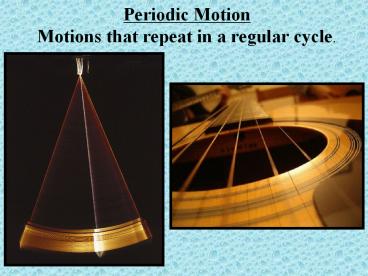Periodic Motion Motions that repeat in a regular cycle. - PowerPoint PPT Presentation
1 / 16
Title:
Periodic Motion Motions that repeat in a regular cycle.
Description:
Periodic Motion Motions that repeat in a regular cycle. Simple Harmonic Motion During motion, object has one point where the net force is zero (equilibrium). – PowerPoint PPT presentation
Number of Views:65
Avg rating:3.0/5.0
Title: Periodic Motion Motions that repeat in a regular cycle.
1
Periodic MotionMotions that repeat in a regular
cycle.
2
Simple Harmonic Motion
- During motion, object has one point where the net
force is zero (equilibrium). - Whenever the object if pulled away from
equilibrium, the net force becomes non-zero and
works to pull the object back to equilibrium. - The force needed to restore equilibrium is
directly proportional to the displacement of the
object.
3
- Period (T) - time for the object to complete one
cycle of motion. - Amplitude - maximum distance that the object
moves away from equilibrium.
4
- Hookes Law - The force exerted by a spring is
equal to the spring constant times the distance
the spring is compressed or stretched from its
equilibrium point. F -kx - Potential energy in a stretched or compressed
spring is equal to one half the product of the
spring constant and the square of the
displacement. PEsp ½ kx2
5
Period of a Pendulum is equal to two times pi
times the square root of the length of the
pendulum divided by acceleration due to gravity.
T 2?vl/g
6
Resonance - the increase in the amplitude of a
vibrating or oscillating object due to the
application of small forces during regular
intervals.
- Pumping your legs when swinging.
- Wind causing the Tacoma Narrows bridge collapse.
7
Wave - a disturbance that carries energy through
matter or space (matter is not transferred).
8
- Transverse Wave - wave pulse (disturbance)
vibrates perpendicular to the direction of the
waves motion. - Longitudinal Wave - wave pulse (disturbance)
vibrates parallel to the direction of the waves
motion.
9
Wave Measurements
- Speed (v) - the speed of a wave pulse is equal to
the displacement of the wave peak divided by the
amount of time. v ?d / ?t - Amplitude (A) - the maximum displacement of the
wave from its position of rest. For waves that
have the same speed, the rate of energy transfer
is proportional to the square of the amplitude. - Wavelength (?) - the shortest distance between
points where the wave pattern repeats itself. - Period (T) - the time it takes wave to complete
one cycle (wavelength). - Frequency (f) - the number of complete
oscillations it makes each second.
10
- The frequency of a wave is equal to the
reciprocal of the period. f 1 / T - The wavelength is equal to velocity divided by
the frequency. ? v / f
11
Wave Behavior
- Incident wave - initial wave that strikes a
boundary. - Reflected wave - returning wave after the
collision of the incident wave with a boundary.
12
Principle of Superposition
- When two waves exist in the same place in the
medium at the same time the displacement of the
medium is equal to sum of the two individual wave
displacements.
13
Wave Interference - the result of the
superposition of two or more waves.
- Destructive - when two waves with opposite
amplitudes meet. If these are equal amplitudes
then the point that they meet (node) does not
move. - Constructive - when two waves with amplitudes in
the same direction meet. Produces an a point
where the largest amount of displacement occurs
(antinode).
14
- Standing waves are produced through the
constructive and destructive interference of
waves. Increasing the frequency of oscillations
increases the number of nodes and antinodes.
15
Waves in 2 Dimensions
- When an incident wave strikes a barrier it will
be reflected. The angles formed between the
incident ray and the normal (draw line that is
perpendicular to the barrier) and the reflected
ray and the normal are equal.
16
- Refraction is the change in direction of a wave
at the boundary between two different media. - For example waves approaching shore will always
have the same frequency, however, their
wavelength and velocity decreases. This will
cause a change in direction between these two
media.

